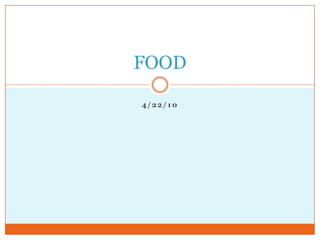Food
- 1. 4/22/10FOOD
- 2. Where Does Our Food Come From?
- 6. Why is it so expensive to eat healthy?http://abcnews.go.com/Technology/DiabetesResource/story?id=4021965&page=1Healthy food is rich in nutrients and low in caloriesPrice of healthy food increased over 20% in two yearsHealthy eating is becoming unaffordablePeople never thought that might be that expensive
- 7. Organic Food & Vegetarian DietsOrganic foodReally regulated industry, special certificatesNot everybody can afford it, healthyhttp://www.organic.org/goorganic/Vegetarian dietsA diet on plant-based foodsUsually people who concerned with animal rights, environmentMust eat wide variety of food to meet their needshttp://www.nlm.nih.gov/medlineplus/vegetariandiet.html
- 9. The New PyramidThe small yellow area is oils (sugar has been removed from the pyramid.)
- 10. Why the Change?Many blamed the old pyramid for childhood obesity.Many people misunderstood the range in what to eat and how much they should consume or couldnŌĆÖt understand it.The new pyramid is more interactive.No more servings, just recommendations (according to a 2,000 calorie diet) along with better eating and exercise habits.
- 11. Grains: Whole and RefinedAny food made from wheat, rice, oats, cornmeal, barley or another cereal grain is a grain product. Bread, pasta, oatmeal, breakfast cereals, tortillas, and grits are examples of grain products.Refined grains:cornbread*corn tortillas*couscous*crackers*flour tortillas*gritsnoodles*Pasta*spaghettimacaroniWhole grains:brown ricebuckwheatbulgur (cracked wheat)oatmealpopcornReady-to-eat breakfast cereals:whole wheat cereal flakesmuesliwhole grain barleywhole grain cornmealwhole ryewhole wheat breadwhole wheat crackerswhole wheat pastawhole wheat sandwich buns and rollswhole wheat tortillaswild riceLess common whole grains:amaranthmilletquinoasorghumtriticalepitas*pretzelsReady-to-eat breakfast cerealscorn flakeswhite breadwhite sandwich buns and rollswhite rice.
- 12. VegetablesOrange vegetables:acorn squashbutternut squashcarrotshubbard squashpumpkinsweet potatoesAny vegetable or 100% vegetable juice counts as a member of the vegetable group. Vegetables may be raw or cooked; fresh, frozen, canned, or dried/dehydrated; and may be whole, cut-up, or mashed.okraonionsparsnipstomatoestomato juicevegetable juiceturnipswax beanszucchiniDry beans and peas:black beansblack-eyed peasgarbanzo beans (chickpeas)kidney beanslentilslima beans (mature)navy beanspinto beanssoy beanssplit peastofu (bean curd made from soybeans)white beansDark green vegetables:bokchoybroccoli collard greensdark green leafy lettucekalemesclunmustard greensromaine lettucespinachturnip greenswatercressOther vegetables:artichokesasparagusbean sproutsbeetsBrussels sproutscabbagecauliflowercelerycucumberseggplantgreen beansgreen or red peppersiceberg (head) lettucemushroomsStarchy vegetables:corngreen peaslima beans (green)potatoes
- 13. FruitsSome commonly eaten fruits are: ApplesApricotsAvocadoBananasBerries:strawberriesblueberriesraspberriesCherriesGrapefruitGrapesKiwi fruitLemonsLimesMangoesMelons:cantaloupehoneydewwatermelonMixed fruits:fruit cocktailNectarinesOrangesPeachesPearsPapayaPineapplePlumsPrunesRaisinsTangerines100% Fruit juice:orangeapplegrapegrapefruitAny fruit or 100% fruit juice counts as part of the fruit group. Fruits may be fresh, canned, frozen, or dried, and may be whole, cut-up, or pureed.
- 14. MilkAll fluid milk products and many foods made from milk are considered part of this food group. Foods made from milk that retain their calcium content are part of the group, while foods made from milk that have little to no calcium, such as cream cheese, cream, and butter, are not. Most milk group choices should be fat-free or low-fat.All fluid milk:fat-free (skim)low fat (1%)reduced fat (2%)whole milkflavored milks:chocolatestrawberrylactose reduced milkslactose free milksMilk-based desserts:Puddings made with milkice milkfrozen yogurtice creamHard natural cheeses:cheddarmozzarellaSwissparmesansoft cheeses:ricottacottage cheeseprocessed cheesesAmericanAll yogurt:Fat-freelow fatreduced fatwhole milk yogurt
- 16. Meat & BeansDry beans and peas are the mature forms of legumes such as kidney beans, pinto beans, lima beans, black-eyed peas, and lentils. These foods are excellent sources of plant protein, and also provide other nutrients such as iron and zinc. They are similar to meats, poultry, and fish in their contribution of these nutrients. Many people consider dry beans and peas as vegetarian alternatives for meat. However, they are also excellent sources of dietary fiber and nutrients such as folate that are low in diets of many Americans. These nutrients are found in plant foods like vegetables.Because of their high nutrient content, consuming dry beans and peas is recommended for everyone, including people who also eat meat, poultry, and fish regularly. The Food Guide includes dry beans and peas as a subgroup of the vegetable group, and encourages their frequent consumptionŌĆöseveral cups a weekŌĆöas a vegetable selection. But the Guide also indicates that dry beans and peas may be counted as part of the ŌĆ£meat, poultry, fish, dry beans, eggs, and nuts group.ŌĆØ
- 17. OilsOils are fats that are liquid at room temperature, like the vegetable oils used in cooking. Oils come from many different plants and from fish. Some common oils are:Some oils are used mainly as flavorings, such as walnut oil and sesame oil. A number of foods are naturally high in oils, like:nuts
- 18. olives
- 19. some fish
- 20. avocados
- 21. canola oil
- 22. corn oil
- 23. cottonseed oil
- 24. olive oil
- 25. safflower oil
- 26. soybean oil
- 27. sunflower oilSolid fats are fats that are solid at room temperature, like butter and shortening. Solid fats come from many animal foods and can be made from vegetable oils through a process called hydrogenation. Some common solid fats are:butter
- 28. beef fat (tallow, suet)
- 29. chicken fat
- 30. pork fat (lard)
- 31. stick margarine

















